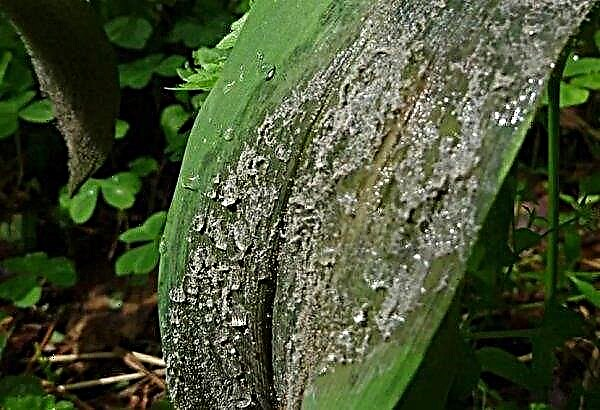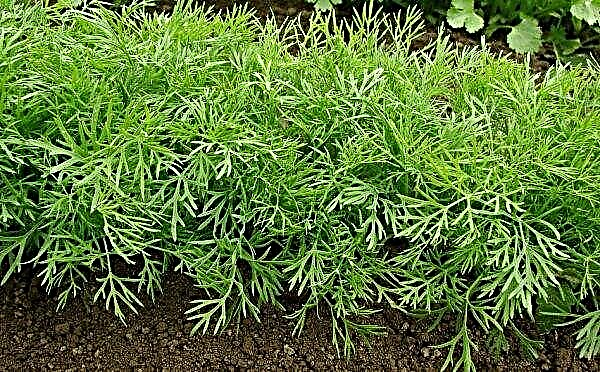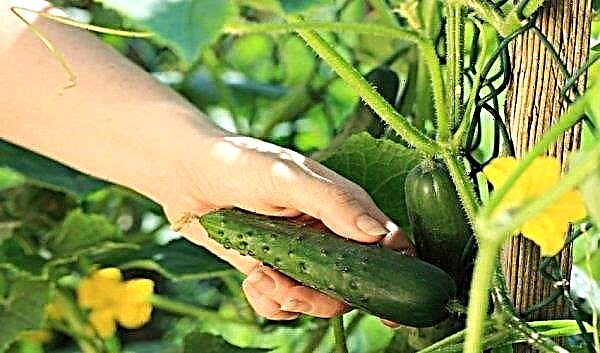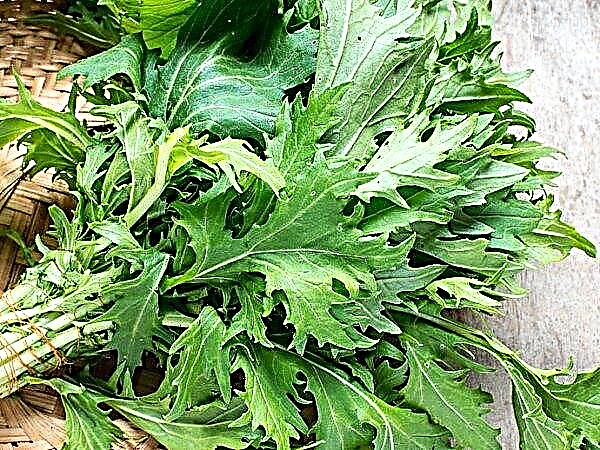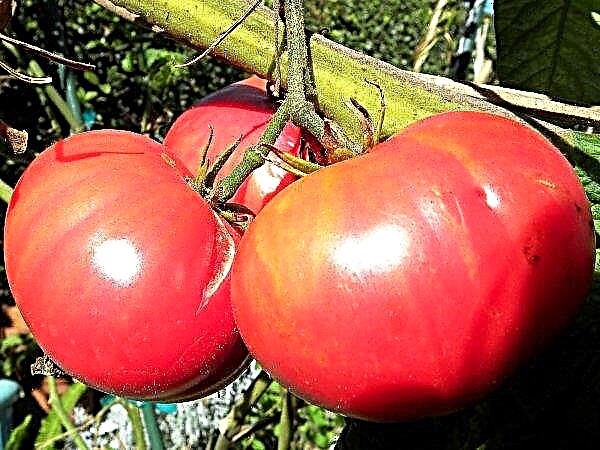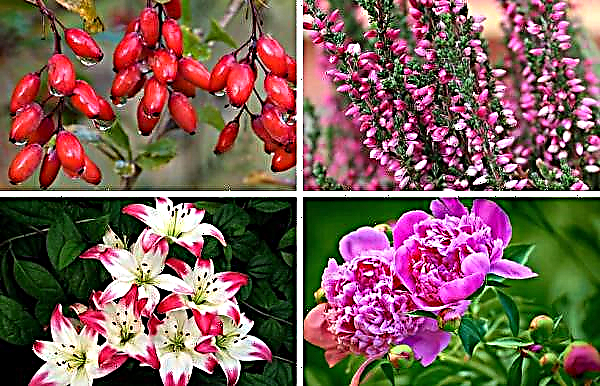Many flower growers prefer unpretentious and beautifully flowering plants both at home and in the garden. One of the most popular and common is ampelous cataract. Abundant, long flowering and easy care make it a favorite among many other flowers.
Description of colors
The widespread availability of Catharanthus is due to its botanical features and appearance.
Botanical features
Katarantus ampelous belongs to the evergreen shrubs of the Kutrov family, at home it is most often grown as a perennial plant, in the garden - as an annual. The bush can reach a height of 50-60 cm (depending on the variety), has straight, branched stems, covered with oblong, rounded leaves of medium size, about 8 cm long with short petioles.
Did you know? The scientific name Catharanthus Roseus in Greek means "clear" or "pure flower", which is associated with a uniform color of its petals.
The foliage has a dark green color, depending on the variety, may have a glossy, smooth or fluffy surface. The flowers are simple, axillary, consisting of 5 petals, the color of which varies from white to purple. A characteristic feature of this flower is the root system, it has a very long rod root, which grows up to 25-30 cm in length and has small filiform processes.
Varieties
Katarantus ampelous is represented by the Cascade variety, which, in turn, includes several subspecies having insignificant differences in the structure of foliage or the color of the petals:
- variety Mediterranean is the most common. This is a curly, low shrub with a height of about 15 cm, with weaving long stems (about 50 cm), covered with small leaves of saturated green color. The flowers of the plant are standard for catharanthus size, about 5 cm in diameter. This variety has several variations: Mix, White and Rose. They differ in the color of their petals: Mix is a shrub with flowers of different shades, White is represented by a plant with white flowers and a purple core, Rose, accordingly, has pink buds of various intensities;
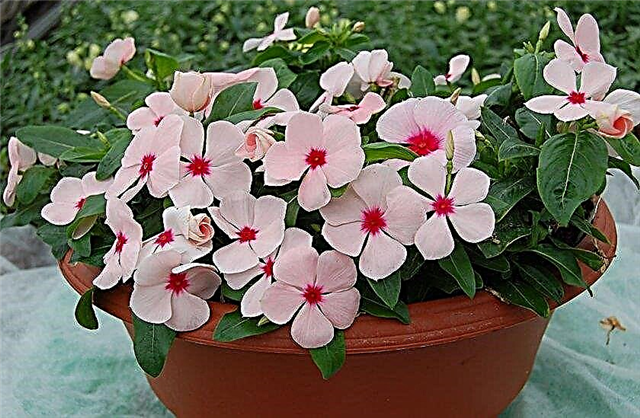
- subspecies titanium is the largest representative of ampelous, the length of its shoots often reaches 70–75 cm. Shrub foliage is glossy, dense, with pronounced veins. Abundant flowering, flowers of a crimson hue. In addition, this subspecies is represented by other bred varieties: White (white flowers), Deep Rose (saturated pink petals), Cherry (cherry flowers), Magenta (purple-purple buds).

Healing properties
This shrub not only perfectly decorates a home or garden, but is also healing. The green of the flower contains alkaloids, which are used in modern medicine to create some groups of drugs for the treatment of cancer patients.
- In addition, traditional healers do not discount the effect of decoction based on catharanthus:
- accelerates the healing of wounds and ulcers;
- relieves gum disease, helps with toothache;
- struggles with inflammatory processes of the female genital organs;
- Helps relieve bronchial disease.
Did you know? Many gardeners know the plant as a periwinkle, however, the external similarity does not rank the catharanthus in this genus. In 1837, after a long study of the features, the flower was identified as a separate genus, although the name "periwinkle" was fixed to it as a folk.
Application
The versatility and duration of flowering make this flower a favorite among flower growers, and its scope is wide:
- absolutely all varieties of plants are suitable for decorating a site: for diluting the composition of a flower bed or mixborder, framing borders, paths, arches;
- ampelous views are ideal for decorating vertical structures, designing terraces and balconies;
- at home, any of the species can be an excellent decoration in the living room or dining room, both alone and in composition with other colors.

Breeding
Although cataractus belongs to perennials, rapid flowering leads to the fact that the resources of the root system are depleted. For this reason, it is most often grown as an annual flower, which is much simpler. A culture can reproduce in several ways, traditional for most flowering plants: by seeds, by the vegetative path and by dividing the bush.
Seeds
Seed propagation of a flower is considered the least expensive way, but not the easiest:
- seeds are purchased at specialized points of sale, because they do not have time to ripen on an ordinary plant over the summer;
- planting material is soaked in a weak solution of potassium permanganate, after which they are ready for sowing;
- a plastic box or container for seedlings is filled with a peat-sand mixture with the addition of humus, but it is better to use a ready-made purchased substrate for flowering plants;
- the seeds are sown in a container to a depth of about 1 cm, then they spray the surface of the soil with warm water and cover it with glass or a transparent film;
- before the first seedlings appear (the first 10-14 days), it is better to place the container in a darkened and warm place, as soon as the sprouts appear, it is immediately transferred to the light;
- the temperature for seedlings should be maintained on the order of +26 ºС, once a day in the first half of the day the film is removed from the seedlings for 10–20 minutes for ventilation;
- when at least 3 leaves appear on the sprouts, the plants are planted in individual containers. Given the rapid growth of the root system, it is better to take flowerpots with a margin of size.
Cuttings
The easiest breeding method for those who already have an adult plant:
- cut and root cuttings is best in early spring, for this cut young green shoots 10-12 cm long from the top of the adult bush, leaving them 1-2 leaves at the very top;
- for rooting, you can put the cuttings in a glass with settled water and wait until the roots appear, after which immediately transfer the young plant to a permanent habitat;
- another option is rooting immediately in the soil. To do this, immediately prepare a pot with soil for flowering plants, plant several cuttings there, water and cover with a cap from a plastic glass. Watered as the soil dries and aerate 1 time per day in the same way as seedlings. When new leaves appear, the plant can be opened and taken care of as an adult.
Video: propagation of cataractus ampelous cuttings
Dividing the bush
This method of propagation is relevant when conducting spring transplantation of an adult overgrown plant:
- the root of the bush is removed from the soil, gently peeling from an earthen coma;
- with a sharp knife that has been treated with any disinfectant, cut the root along, dividing the plant into two bushes;
- places of cut sprinkled with crushed activated carbon;
- a new plant is planted in a separate pot and taken care of as an adult.
Important! When choosing seeds, it is better to give preference to trusted manufacturers and check the integrity of the packaging and expiration dates, this is the key to good germination of the material.
Household conditions and care
Katarantus is an unpretentious indoor plant, for a comfortable existence, simple care is quite enough for him.
Lighting
The shrub does not tolerate scorching sunlight, it will be much more suitable for intense, but diffused light, for example, the windowsill of a window facing the east or southeast side. When kept in a room facing the West, it is better to remove the flower a certain distance from the window.
Temperature mode
During the flowering period, that is, from May to October, the most comfortable temperature for the bush will be + 24 ... + 26ºС. With the onset of winter cold, you can transfer it to a room where the temperature does not drop below + 12 ... + 15ºС, because near the central heating batteries the plant will begin to wither away from dry air.
Watering
The shrub is very moisture-loving, like most people from the tropics. First of all, the humidity of the surrounding air is important, it should be 75–80%, the foliage of the plant should be periodically irrigated from the spray gun. Watering should be done regularly, while waiting for the top layer of the substrate to become dry.
Important! For all its moisture-loving nature, the cataractus does not tolerate stagnation of water in the sump and root zone, so it is important to ensure good drainage and install the pots on a pebble layer so that their bottom does not stand in the water after watering.
In autumn and winter, watering is reduced, however, taking into account external conditions (if the flower is next to the heater, watering should be done more often). You can not water the plant with cold water (below +22 ºС), it is better to use slightly warmed up or room temperature.
Top dressing
Flowering plants requires a large-scale expenditure of nutrients, which may be insufficient in the soil, so the flower must be fed regularly. For this, once every 7–10 days, simultaneously with irrigation, liquid fertilizing of industrial production intended for flowering plants is introduced into the flowerpots. It is important to strictly follow the manufacturer's instructions on the packaging to avoid root damage. After flowering, fertilizing cataractus is not necessary.
Pruning
Pruning a plant is necessary for several reasons:
- allows you to refresh the bush, saving it from old shoots, which contributes to a more intense flowering;
- makes it possible to form a bush of the desired type.
 The procedure is carried out in early spring before the start of the growing season. Usually cut off the oldest stems, leaving 1/3 of them. To give the bush a certain shape, pinch the necessary shoots with your fingers on 2-3 leaves from the top.
The procedure is carried out in early spring before the start of the growing season. Usually cut off the oldest stems, leaving 1/3 of them. To give the bush a certain shape, pinch the necessary shoots with your fingers on 2-3 leaves from the top.Transfer
Katarantus belongs to fast-growing crops, so it is mandatory to transplant it annually, and in some cases twice a year. Mandatory is a transplant in early spring, before the plant begins to bloom. The pot is chosen deeper, while the width is not a fundamental requirement. With intensive growth, another transplant can be made in late summer - early fall.
The plant is transshipped along with a radical earthen lump. The soil should be neutral (acidic environment is detrimental to the roots), with an equal content of peat, sand, turf, humus. It is safer to use a ready-made mixture for roses or other flowering plants. At the bottom of the flowerpots, it is necessary to pour 1–1.5 cm of expanded clay to ensure drainage.
Video: Catharanthus transplant
Features of growing catharanthus in the garden
This flower is equally unpretentious both as a home plant and as a garden culture. Growing it in open ground has its own characteristics.
Disembarkation
So, it is possible to plant young seedlings only after the night frosts end and warm weather sets in, it is better to do this in late spring, in May - early June. Before transferring the seedlings to the site, it is hardened for 10-12 days, taking it out into the open air and gradually increasing the residence time. For planting a flower, it is better to choose a windproof, flat area in a well-lit part of the garden. The soil should be light, loose, fertile, low acid. Before planting, the earth is dug up, mixing with a ready-made soil mixture of peat, turf and sand. Expanded clay, perlite or any other available type of drainage is poured under the main landing layer. Bushes are planted in moist soil, in prepared holes at a distance of at least 30 cm from each other.
For planting a flower, it is better to choose a windproof, flat area in a well-lit part of the garden. The soil should be light, loose, fertile, low acid. Before planting, the earth is dug up, mixing with a ready-made soil mixture of peat, turf and sand. Expanded clay, perlite or any other available type of drainage is poured under the main landing layer. Bushes are planted in moist soil, in prepared holes at a distance of at least 30 cm from each other.
Care
Caring for a quarantine in the garden is no more difficult than at home. All that he needs is timely watering, periodic weeding of weeds, cultivation and regular top dressing. Watering the bushes is necessary as the top soil layer dries (to a depth of 2 cm). With underfilling, the foliage of the plant begins to dry out and curl. Water for flowers is heated in the sun, carefully watered under the root, trying not to erode the ground.
In hot periods, you need to arrange a catharanthus of souls, irrigating the leaves from a watering can, it is important to do this not under the scorching sun. Weeding the planting is necessary until the bushes grow in full force, after which the weed grass simply has nowhere to grow. Periodically after watering, you need to loosen the top layer of the earth, but not too deep, up to 2 cm.
Growing a flower in an open area requires regular maintenance by feeding. It is advisable to fertilize the culture once every 20 days during the entire flowering period, until the end of September. Many gardeners use the root method of fertilizing with various organic and mineral complexes.
However, if the dosage is not respected, this is fraught with burning of the roots and death of the bush. It is most safe to use the foliar method of dressing with biological products (for example, "Epin-Extra"), they are bred according to the instructions and the crown is sprayed with the resulting composition.
Possible problems
Katarantus is weakly affected by various diseases and pests, however, some of them can be dangerous.
In addition, a violation of the care regimen can also provoke a deterioration in the condition of the flower:
In addition to diseases and pests, in violation of the conditions of detention, the cataractus may show signs of the disease:
- yellowness and foliage twisting are the result of low humidity and heat;
- decrease in flowering intensity occurs with hypothermia of the plant;
- complete stop of flowering and withering of the crown They say that the root system is closely in a pot.





